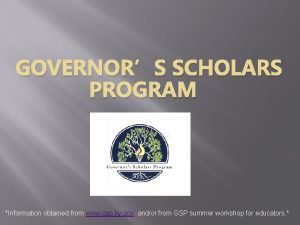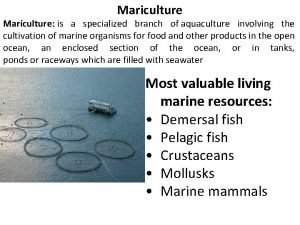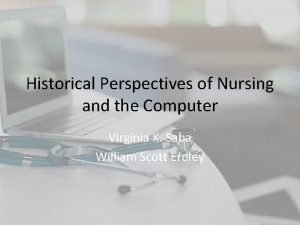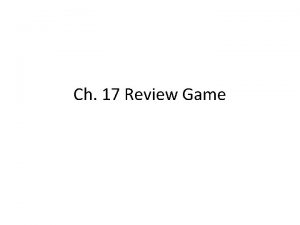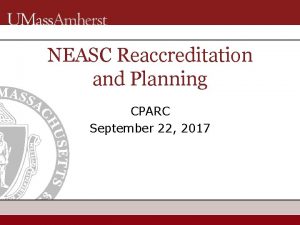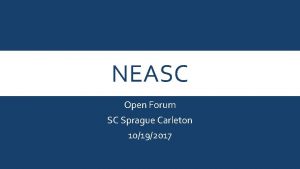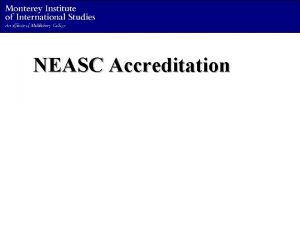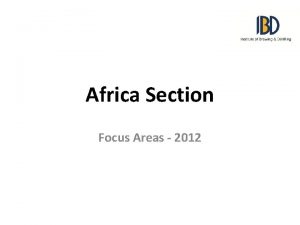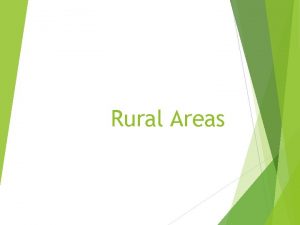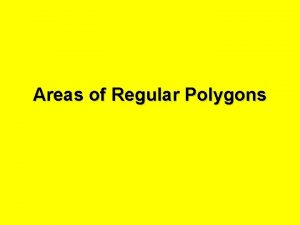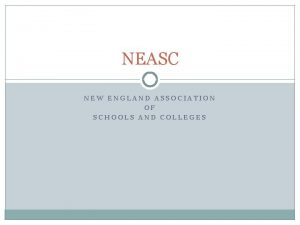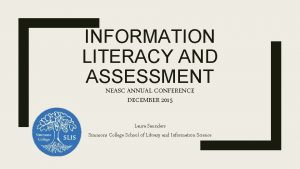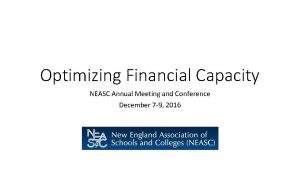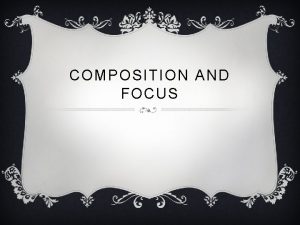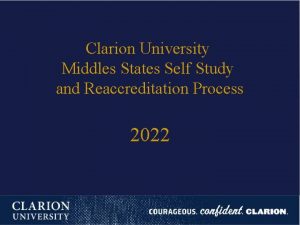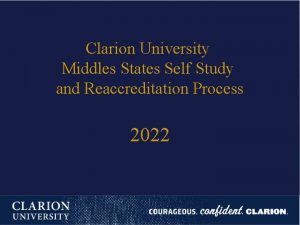Reaccreditation and Planning NEASC Major focus areas Demonstrate














- Slides: 14

Reaccreditation and Planning: NEASC § Major focus areas • Demonstrate a sustainable financial strategy • Move to the next level in planning, assessment and improvement • Demonstrate leadership in using evidence to improve the student experience § Increasingly important for all colleges and universities § Central to our own strategy Joint Task Force for Resource Allocation 1 1

Approach for Self Study Development NEASC Standards Compliance • Federal definition of a student credit hour • Identity verification for online students • Financial statement, audit standards 2009 Self Study Review and update as needed 2018 Self Study Substantive • Faculty are demonstrably effective. . . • Student success is measured and results used to improve • Multi-year financial planning is realistic Joint Task Force for Resource Allocation 2017 Strategic Plan Progress and Refresh Unit Plan refresh 2 2

Strategic Plan “Refresh” — What is it? § Step One: Understanding our Situation • Are original assumptions still valid? • Situation analysis with campus leaders § Step Two: Priorities for Action • Does the plan still fit? • Working Groups • • • Diversity Undergraduate Experience Graduate Education Research and Scholarship Outreach and Engagement Resources Joint Task Force for Resource Allocation 3 3

FY 19 Planning and Budget Process § Working with Provost’s Office to finalize guidelines for Schools and Colleges • One set of instructions § Incorporate CPARC recommendations from May 2017 • More explicit feedback to departments (initial and final) • Include space/facilities implications • Sharper focus on use of evidence § Departmental Resource Profiles § Internal College allocation processes Joint Task Force for Resource Allocation 4 4

A Culture of Evidence Intentions What are we trying to accomplish? Evidence Planning Assessment Improvement What do we know? Analysis What do we make of it? Priorities What should we focus on? Actions What are we going to do? Description Appraisal Projection

A Culture of Evidence Intentions What are we trying to accomplish? Undergraduate Experience Graduate Education Research and Scholarship Administrative & Support Services Evidence What do we know? Analysis What do we make of it? Priorities What should we focus on? Actions What are we going to do? Strategic Plans Accreditation Periodic Review (AQAD, Ad. QAD)

Student Outcomes Assessment/Student Experience

Outcome: Group Work (direct evidence) Inputs Resources or conditions feeding into the process Outputs Products of the process Processes What we do Outcome: Group Work (self-report) ! Process: Advising (satisfaction) Outcome: Critical Thinking (direct evidence) Process: Faculty Interaction Outcome: (satisfaction) Critical Thinking Critical (self-report) Input: Class Size (observation) Output: Time to Degree (observation) Outcome: Problem Solving (direct evidence) Outcome: Subject Matter (direct evidence) Output: Graduation Rate Graduation (observation) Outcome: General Experience (satisfaction) ! Outcome: Quantitative Analysis (direct evidence) Output: Persistence in Major (observation) Outcome: Quantitative Analysis (self-report) Outcome: Problem Solving (self-report) Output: Further Education (observation) ! Output: Student Retention Student (observation) Outcome: Matter Subject Matter (self-report) Input: High School GPA (observation) Outcome: Writing (self-report) Process: Career Preparation (satisfaction) ! Process: Teaching (satisfaction) Outcome: Writing (direct evidence) Output: Career Achievement Career (observation) Outcomes What happened in terms of objectives?

Outcome: Group Work (direct evidence) Outcome: Subject Matter (direct evidence) 3 Process: Teaching (satisfaction) ! Outcome: Critical Thinking (direct evidence) Outcome: Quantitative Analysis (direct evidence) Outcome: Problem Solving (direct evidence) Outcome: Writing (direct evidence)

Outcome: Group Work (direct evidence) Outcome: Subject Matter (direct evidence) Outcome: Critical Thinking (direct evidence) ! Outcome: Critical Thinking (self-report) 3 Outcome: Quantitative Analysis (direct evidence) Outcome: Problem Solving (direct evidence) Outcome: Writing (direct evidence)

Outcome: Group Work (direct evidence) Outcome: Subject Matter (direct evidence) Outcome: Critical Thinking (direct evidence) Input: Class Size (observation) ! Outcome: Problem Solving (direct evidence) Outcome: Quantitative Analysis (direct evidence) 3 Outcome: Writing (direct evidence)

• • • Outcome: Group Work (direct evidence) Outcome: Knowledge specific to your. Subject major Matter (direct evidence) Analyzing quantitative problems Ethical decision making Outcome: Critical Thinking Using computing and information technology (direct evidence) Solving complex problems Writing clearly and effectively Speaking clearly and effectively Thinking critically and analytically Outcome: Quantitativewith others Working effectively Analysis (direct evidence) Learning effectively on your own Outcome: Relating to people different from you(direct. Writing evidence) Understanding your own strengths and weaknesses Outcome: Problem Solving (direct evidence)

2007 and 2008 Graduating Classes Alumni Survey Outcome: Alumni Working Full or Part Time (N=532) Group Work Outcome: (direct evidence) Used at Work: To a Great Extent UMass Contribution: Quite a bit Subject Matter (direct evidence) 100% 90% 80% Outcome: Critical Thinking (direct evidence) 70% 60% 50% 40% 30% 20% ef d an ly Th ak in gc ar le Sp e Outcome: Writing (direct evidence) le fe in ar ct kin ly ive an gc ly d rit e ica ffe W l ct ly or ive an kin ly d ge an ffe Le al yt ar ct ica ni ive ng lly Re ly ef w la fe ith tin ct gt ot ive he o l yo pe Un rs op n de yo le rs ur ta di nd ffe ow in r n e gs nt tre fro ng m th yo s/ u w ea kn es se s m ob le pr ex pl rit W So l in vin gc om fo in nd in ga pu t om gc ch io n at rm isi de c ca l hi Et Us in te in ak on m ob l pr ive at tit ua n Outcome: Problem Solving (direct evidence) gc s em or aj ur m yo o ct yz in gq sp ec ifi e An al dg le w Kn o g 0% s Outcome: Quantitative Analysis (direct evidence) 10%

 Porter's generic business strategies
Porter's generic business strategies Business level strategy cost leadership
Business level strategy cost leadership Prolepsis
Prolepsis Actor focus vs object focus
Actor focus vs object focus Gsp essay examples
Gsp essay examples Accenture methodology
Accenture methodology Major fishing areas of the world
Major fishing areas of the world Historical perspective of nursing process
Historical perspective of nursing process Demonstrate knowledge and understanding
Demonstrate knowledge and understanding Miller and urey's experiments attempted to demonstrate
Miller and urey's experiments attempted to demonstrate Personal care skills chapter 6
Personal care skills chapter 6 Demonstrate good subject and curriculum knowledge
Demonstrate good subject and curriculum knowledge N planning
N planning Long medium and short term planning in primary schools
Long medium and short term planning in primary schools What is language planning
What is language planning




